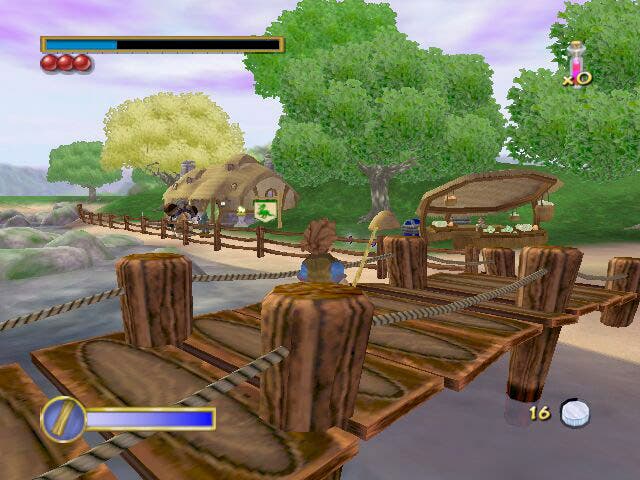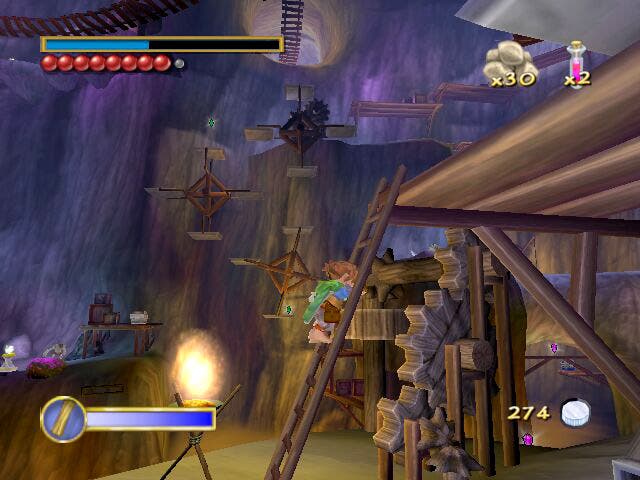The Hobbit
Vivendi takes us there and back again.
Film trilogy rights-holder Electronic Arts may have won the war of the rings with its two towering next-generation console titles, but Vivendi-Universal Games continues to plug away with its literary adaptations, and as Peter Jackson's cinematic treatment of The Lord of the Rings continues to help shift Tolkien books in ever-increasing numbers, two unlikely events aligned in chez Bramwell this month that signalled the start of a grand quest - I read The Hobbit for the very first time, and then Vivendi's reworking of the book rose to the top of my backlog.
No Shire than before

Having turned the last page of the book just a few short nights ago, slipping into Bilbo's shoes - or rather into his leathery feet - seemed like the perfect thing to do before I began reading The Lord of the Rings. And indeed, with characters, events and dialogue still charging around my head like a goblin horde between the arms of a mountain, Vivendi's re-imagining of Tolkien's original tale, charting the quest of a young hobbit, thirteen dwarves and a wizard across Middle-Earth, over the mountains, through the forests of Mirkwood, past Lake-town and into the belly of the beast, had a certain amount of leeway to play with. After all, I'd barely finished caring for these characters and their tale - and that residual interest kept me going far longer than I would have otherwise.
For stripped of its significant wrapping, Vivendi's Hobbit game is actually one of the most painfully average platform/slasher games in recent history. Apart from taking a few too many liberties with the subject material, padding out early sections and then cutting a huge chunk out of the middle, it's also guilty of some hideously ropey graphics, repetitive level design, dodgy pacing and far too many find-the-key routines. It's also yet another third-person run-and-jump game that suffers in comparison to Prince of Persia, which really ought to be a required course for any game designer working on a third-person title from now on.
Maximo of the Ring

It all starts rather oddly. As soon as the game begins, the player is dumped without warning into unfortunate Bilbo's position immediately ahead of a massive battle between goblins and dwarves. After hacking and slashing this way and that for a while with trusty sword Sting, Bilbo awakes from this dream sequence prologue, and through a mixture of CG cut sequences, tapestry-style drawings and a nice gruff voice over, the player is told of young hobbit's accidental quest. Having been effectively press-ganged into the role of burglar for a motley band of dwarves, Bilbo sets off on a mission to reclaim their ancestors' treasure horde from the dragon Smaug, with the player taking control shortly after Bilbo wakes up on the morning his adventure begins.
Having been ordered to the local inn to meet the dwarves by an impatient Gandalf, the player is given control of Bilbo who can run and jump around collecting silver pennies and other jewels (a recurring theme), hack at objects with his walking stick, switch to a first-person view to throw stones, and talk to his fellow Shire hobbits to collect simple missions. Serving as something of a tutorial, this Shire level has Bilbo collect items like apples, hammers, nails and even needles hidden away in all sorts of nooks and crannies before he's able to cross the river and join his fellow adventurers. There's climbing through the rafters to be done, plenty of narrow platforms to leap between and a good deal of items to be retrieved.
What follows generally speaking falls into the Maximo/Ratchet & Clank School of Platforming - sometimes tricky platform sections broken up by sometimes overwhelming battles with multiple protagonists, with the player being pulled hither and thither to mind multiple objectives. Except in the case of The Hobbit, the combination of an awkward camera that, despite a number of inversion options, can't ever seem to show what you'd like it to show, and a rather directionless/unresponsive protagonist often conspire to pile on the frustration in any combat scenario. Platform sections too are hindered by relatively daft technical failings, like an inability to tell exactly which way you're facing when hanging from a rope, which becomes crucial, or an inability to move objects faster than a couple of inches per second.
Supplies!

This theme of having several small sub-quests ongoing at the same time is continued throughout, and although optional, completing quests like collecting a family heirloom for a wounded soldier in the forest will reap many benefits - hint scrolls for example, which are effectively upgrades that "teach" Bilbo (read: unlock) the ability to jump further, slash two or even three times in a row and so on. And of course jewels and coins, which can and must be spent on health potions, poison antidotes and other items on the between-level shop screen.
However it seems to me that there's rather too much collecting to be done in The Hobbit given its rather unyielding mechanics. Whereas Maximo gets away with sending the player everywhere, and folks like me get off on locating every chest and securing that 100 per cent rating, The Hobbit replaces chests and items when you die, forcing you to retrace every step, and while Maximo still kills the player quite regularly, it's rarely as unjustified as some of the deaths I've had in The Hobbit. Water, for example, is almost universally fatal - in one particularly memorable section set in Mirkwood, I fell into a pit, the idea being to uncork a water source and float to the top. However it didn't immediately occur to me that I'd have to find something wooden to stand on, and as such I stood there for a few seconds, drowned and then watched the camera pan round to a nice floating wooden platform. Then there's the rope issue I've already mentioned, which transcends the niggle/flaw boundary during an extended section of narrow branch/vine navigation that had me screaming at the television.
Nevertheless though there are some areas that deserve praise. As the game unfolds from Bilbo's perspective, the player misses out on Gandalf and the dwarves' encounter with the Great Goblin in the tunnels of the Misty Mountain, but the developer has actually lined up some surprisingly vast, intricate and impressively designed cave platforming sections, which offer steady progress, plenty of unexpected treats and a few memorable moments, even if one such moment - a mine cart getaway over the tracks snaking through the murky heart of the mountain - goes from cute to peculiar to tedious when you realise you're being relied upon somewhat to direct traffic. It's also worth mentioning the recurring chest puzzles - a visualisation of the lock-picking process that has you trying to stop the cursor on a green bar in a number of quick-fire reaction-based puzzles.
Metal Gear Baggins

Since Bilbo spent a heck of a lot of time wearing his soon-to-be infamous ring in the book, it's little surprise to find the player sneaking around, even before he gets hold of it. The developer's first excuse for the stealth mechanic is the hobbit's encounter with a trio of trolls on the road to Rivendell. Having platformed and slashed his way to their fireplace, Bilbo has to sneak past them a number of times without rustling leaves, brushing them in his haste or falling into their line of sight. Doing so sees him quickly caught and the task reset.
However anybody with a decent memory of the book is probably thinking "hang on, I thought the whole point was he did get caught?" It's certainly something that occurred to me when I was hauled back a ways while inches from pick-pocketing a lazy troll, only to manage it a couple of minutes later amidst similar resultant scenes of mayhem. The developer then pads this section out by tacking on a rather middling trip into the hillside in search of a key for the trolls' stash cave. It's a daft inclusion in the first place, but it seems doubly daft when you consider how much cave-related content there is to be found in the book. Would you really choose a cave section to pad it out?
That said though, fans of the book are the most likely to enjoy this. Those who haven't read it would be best advised to buy the book and read it instead of going anywhere near this - without the requisite enthusiasm for the subject matter it becomes something of a bore rather quickly, the fiddly third person mechanics and dodgy visuals, which even the PS2 would be rather ashamed of, more than enough to derail any enthusiasm before it bursts to the fore. There were plenty of occasions I could have just given up out of spite and lack of interest, and plenty of things that would have had me back down the shops with receipt in hand quicker than a hobbit making breakfast, but obligation and my soft spot for the book and characters kept me going.
Tolkien liberties

Whether die-hard Tolkien fans will be willing to stomach the liberties taken here though is another matter. To give you some idea beyond what I've already said, after the Misty Mountains the entire section concerning wolves, trees, eagles, honey-supping Beorn and most of the trip through Mirkwood are quickly glossed over in a few vague lines of dialogue. Obviously with "The Prelude to The Lord of the Rings" written on the box you'd expect a heavier emphasis on the Gollum encounter than much else, but even that seems to be cut rather short, with none of the superb riddles from the book making it across intact. Other than "What's in my pocket?" that is.
At the end of the day, The Hobbit just doesn't stand out. We're anxious to encourage direct literary adaptations, but this game just robs the tale of its intricate detail, imagination and character development. What we're left with really is a Saturday morning cartoon retelling of the tale, with none of the memorable dialogue, very little actual exposition, too much brainless padding and key events reshaped to fit the brief - like turning the spider's nest dwarf rescue into a respawning spider boss section with a few ropes to cut. For anybody who thinks of Mirkwood when the lights go out, the surprisingly well-lit forest in Vivendi's Hobbit seems unbelievable, and compared to the luscious detail on display in Peter Jackson's celebrated vision of Lord of the Rings, what we have here is just plain dull, with drab, low-res texturing, sharply angled models and some awkward collision detection. What's more, despite the bravest efforts of the voice actors - including a Gandalf who seems to get better and better at his impression of Sir Ian McKellen - methinks this was always destined to fall slightly short.
Although undoubtedly defensible, The Hobbit is a common-or-garden 3D platform/slasher in the same form as Maximo, wrapped up in a five year-old's bedtime story version of one of the most popular fantasy books ever written. It's ten hours of a fairly easy going platform slashing with well-spaced save points, and young gamers might get something out of it too, but for the majority it just is not good enough. Fans of the book can add a point, as long as they have the stomach for pangs of disappointment, but the rest of you would be better served shopping elsewhere in this already crowded genre.








